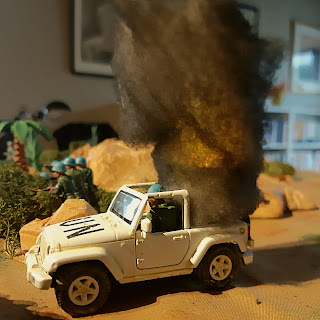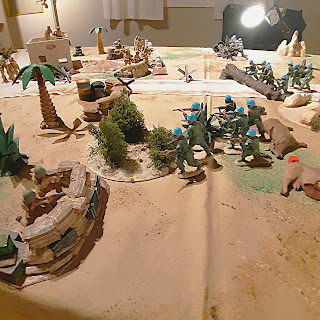Wargame In a Bag 2 - The Second Battle for Lumbaya
The rules
It seems that 'Murphy's Law of Combat' also goes for wargames, because right after I played and reviewed the last game, 'Wargame In a Bag' in the previous post, I found the written 'Wargame In a Bag' rules by Nick Grant. I don't think the document is searchable through Google either, so this might be the only place that its link is published as far as I know. This is the same written rules as in the description-section that earlier followed the demonstration-video on Youtube, and contains the optional rules for 'Wargame In a Bag'.
And as I vaguely remembered, it it had optional advanced rules for covering heavier weapons like HMG, bazooka, mortar and hand grenades. So with the addition and support of these heavier weapons, would the outcome of 'The First Battle of Lumbaya' been different for the UN forces? There was actually just one thing to do, and that was to make another similar setup and have another try in 'The Second Battle of Lumbaya' to find out.
The scenario
The UN have already tried to take the Katangese Stronghold of Lumbaya once during operation '
Grand Slam', but the operation was unsuccessful. Therefore The ONUC HQ orders another UN platoon to have go in 'The Second Battle of Lumbaya'.
Forces:
- After the first battle of Lumbaya, the Katangese forces has been reinforced, and are back to:
- 2 rifle-squads each of 10 soldiers, a LMG and and a bazooka/flame thrower. Each squad can operate as 2 fireteams independently.
- 1 HMG-detachment of 3 soldiers
- 1 sniper
- HQ-section with platoon-leader and 2 medics
- After turn 12 if rules include vehicles or skilled troops: A QRF consisting of 1 truck with a HMG and a section of 10 'veterans' with a LMG and a bazooka arrives from the next village. Only if Lumbaya is still held by Katangese forces. Since these rules doesn't support vehicles, the QRF enters the village at foot.
- The UN use an identical strengthen platoon of:
- 1 Platoon of 3 rifle-squads each, of 8 soldiers and a LMG. The squads can operate independently.
- 1 Light mortar-detachment of 2 soldiers and an observer
- 1 bazooka-detachment of 3 soldiers
- HQ-section with platoon-leader
- 1 Jeep with HMG and 2 soldiers. Since these rules do not include vehicles, the Jeep stayed stationary with the HMG at the deployment-area acting as 1 unit.
Mission:
- Katangese: To hold the strongpoint of Lumbaya. Can request QRF-support as mentioned in the force-section from turn 12 if still holding whole or part of the strongpoint.
- UN: To take and hold the strongpoint of Lumbya, preferably within 12 turns, and take control on as many Katangese gendarms located there as possible.
AAR
Time: 1 hour and 50 minutes
Turns: 9
Result: UN victory
With these (written) optional rules, the UN support-weapons made a better effect supporting the advancing squads...
...and kept the Katangese rooftop HMG under constant heavy fire. This made it less effective...
...and the UN squads managed to advance from cover-to-cover closer to Lumbaya, meeting only light fire.
When the UN mortar finally got a direct hit and eliminated the Katangese heavy-weapons, they also managed to poke a hole in the Katangese line of defence.
The way to Lumbaya was now practically open, but the UN-platoon advanced carefully with fire and maneuver, letting the squads cover each other.
The last defenders of Lumbaya tried to slow down the UN attack, but came under heavy fire and started to take a toll.
This made it possible for the UN squads to finally enter the village of Lumbaya.
When the UN entered Lumbaya, the last Katangese defenders tried to retreat to another cover, but was hit and taken out before entering their new possitions.
And in turn 9 UN entered the village with almost an intact platoon.
So at the second attempt the UN managed to clear the Village of Lumbaya in the UN-Operation 'Grand Slam'. The UN mission in Congo was to last for many years, and there would be further clashes for the UN-troops to come in this conflict...
-Some of them might be covered in this blog.
Off course mostly of the Pros and Cons are the same, as the rules are practically the same as previously reviewed for this game. So therefore I'll mention the Pros and Cons only related to the optional rules not covered in my last battle report.
Pros
- Units gets a -1 for each time getting shot at in a turn, when they're shooting back. I think this represents suppressive fire in a good way, as it will make them keeps their heads down and not being able to fire back as efficient.
Cons
- Even being optional rules with heavier weapons, these rules still don't cover other special weapons like flamethrowers, sniper rifles or light machine guns.
- I think the rules are a litte contradictory about how to calculate the mortar fire, but I choosed to play it as mentioned in the example.
Conclusion
These rules seems to fill in some missing parts I called for in my first review of 'Wargame in a Bag' (based upon the YouTube-clip). Even if it stills lack some other heavier weapons, I think these optional rules makes this game even more playable showing the importance of cover, the effect of suppressive fire and the danger running from one cover to another. Both my reviews have to be read for a complete overview of the Pros and Cons for this game.
If you read this, I hope you do so because you have followed my series of test-playing various easy and free downloadable wargame rules for regular toy-soldier or army men this year. If so I hope you have found it useful and got inspired to try some of them out yourself.
There are a lot of more free, simple, playable and fun wargame rules out there, but I think I have found the rules that pleases me and I hope you found these play-throughs useful. Use the games that suits you and make you happy and have fun!


















































